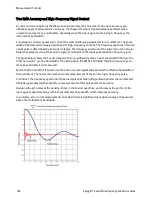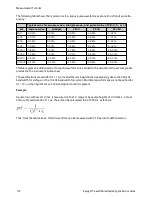
Digitizing Measurements
The digitize mode applies only to the 34465A/70A with the DIG option, and as is available only from the
DMM's front panel. The digitized mode provides a front–panel user interface that allows you to quickly set
up digitized measurements.
Digitizing is the process of converting a continuous analog signal, such as a sine wave, into a series of dis-
crete samples (readings). The figure below shows the result of digitizing a sine wave. This chapter discusses
the various ways to digitize signals. The importance of the sampling rate, and how to use level triggering.
The Sampling Rate
The Nyquist or Sampling Theorem states:
If a continuous, bandwidth-limited signal contains no fre-
quency components higher than F, then the original signal can be recovered without distortion (ali-
asing) if it is sampled at a rate that is greater than 2F samples per second.
In practice, the multimeter’s sampling rate must be greater than twice the highest frequency component
of the signal being measured. From the front panel you can select a sample rate in samples per second
using the
Sample Rate
softkey. You can also set the sample rate indirectly by specifying the sample inter-
val (the time from the beginning of one sample to the beginning of the next sample) using the
Sample
Interval
softkey.
The figure below shows a sine wave sampled at a rate slightly less than 2F. As shown by the dashed line,
the result is an alias frequency which is much different than the frequency of the signal being measured.
Some digitizers have a built-in anti-aliasing low-pass filter with a sharp cutoff at a frequency equal to l/2
the digitizer’s sampling rate. This limits the bandwidth of the input signal so that aliasing cannot occur.
Since the multimeter has a variable sample rate for DCV digitizing, and to preserve the upper bandwidth
Keysight True
volt
Series Operating and Service Guide
177
Measurement Tutorial
















































